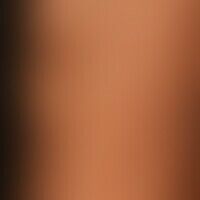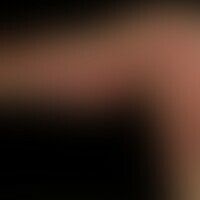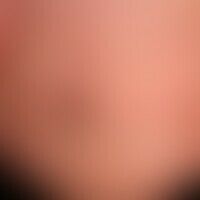Image diagnoses for "red"
877 results with 4458 images
Results forred

Purpura thrombocytopenic M31.1; M69.61(Thrombozytopenie)
Purpura thrombocytopenic: Hemorrhagic spots with a tendency to confluence, existing on both lower legs with emphasis on the extensor sides. It is a drug-induced form of a thrombotic- thrombocytopenic purpura with hemolytic microangiopathic anemia and central nervous failure symptoms. The trigger was the ingestion of non-steroidal anti-inflammatory drugs. Sudden onset with fever, disorientation, stupor.

Lupus erythematodes chronicus discoides L93.0
Lupus erythematodes chronicus discoides: older, only slightly active "discoid" lupus foci that heal under atrophy of skin and subcutis (focal destruction of hair follicles) Note the reddish-livid hue of the alopecic foci.
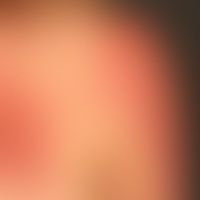
Contact dermatitis allergic L23.0
Pronounced. large-area allergic contact eczema: large, blurred (scattered edges), itchy, red, rough, scaly plaques that have existedfor 4 weeks.

Seborrheic dermatitis of adults L21.9
Dermatitis, seborrhoeic: Detailed view: Coarse lamellar scaling, erythematous plaques.
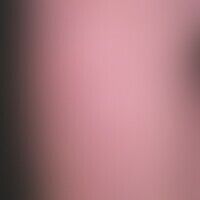
Sweet syndrome L98.2
Dermatosis acute febrile neutrophils: acute, exanthematic clinical picture with affection of face, neck, trunk and extremities; here detailed picture of the lower leg with red, succulent papules and plaques.
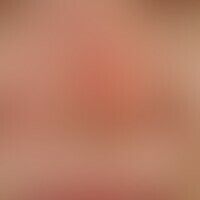
Psoriasis vulgaris L40.00
Psoriasis vulgaris: Erythematous, scaly plaque on the tip of the nose of a 34-year-old woman, which appeared for the first time about 1.5 years ago and measured about 1.5 cm.

Atopic dermatitis in children and adolescents L20.8
Eczema atopic in child/adolescent: 12-year-old child; acute episode of the previously known atopic eczema with vesicular, occasionally also pustular plaques.

Erythronychia longitudinalis; L60.9 L60.8
Erythronychia, localized longitudinal detail magnified by reflected light microscopy; solitary, painless, red longitudinal striation of the nail plate with slight, V-shaped retraction and several splinter hemorrhages.

Acne (overview) L70.0
Acne papulopustulosa: disseminated follicular inflammatory and non-inflammatory papules, pustules and retracted scars; recurrent course.

Early syphilis A51.-
Syphilis Early syphilis: discreet , non-itching or painful, maculo-papular palmar syphilis

Mononucleosis infectious B27.9
mononuleosis, infectious. generalized (almost universal) macular exanthema. raspberry tongue with swollen papillae. tongue surface completely free of coating.
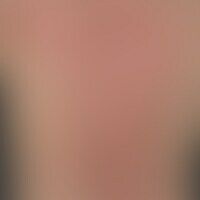
Lupus erythematosus (overview) L93.-
Rowell's Syndrome: Erythema exudativum multiforme-like exanthema in "subacute cutaneous lupus erythematosus

Dyskeratosis follicularis Q82.8
dyskeratosis follicularis. presentation of multiple, chronically stationary, disseminated, red nbis rfot-brown papules localized in the submammary and upper abdomen. in these areas strong increase of skin changes, especially in summer with increased sweating.

Pemphigus chronicus benignus familiaris Q82.8
Pemphigus chronicus benignus familiaris: chronic, sharply defined, red, rough plaque with multiple, spontaneous and, when stretched, gaping, streaky erosions (accordion phenomenon)
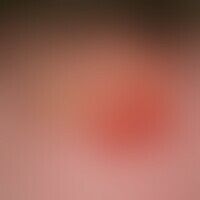
Cryptococcosis B45.9
Cryptococcosis of the skin: Crusty plaque of approx. 3 x 3 cm in size surroundedby a reddish, slightly raised rim in the middle of the forehead of a 37-year-old HIV-infected person (not set to HAART at the time of presentation).

Folliculitis barbae L73.8
Folliculitis barbae: Eminently chronic therapy-resistant (no significant improvement under systemic antibiosis), folliculitis of the child and neck
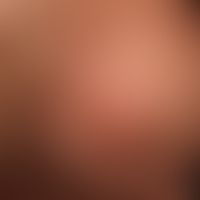
Tinea capitis profunda B35.02
Tinea capitis superficialis: easily inflammable, blurred, alopecic focus in the occipital region in a 7-year-old boy. low crust formation. no itching. no pain. fungal culture: Trichophyton mentagrophytes.

